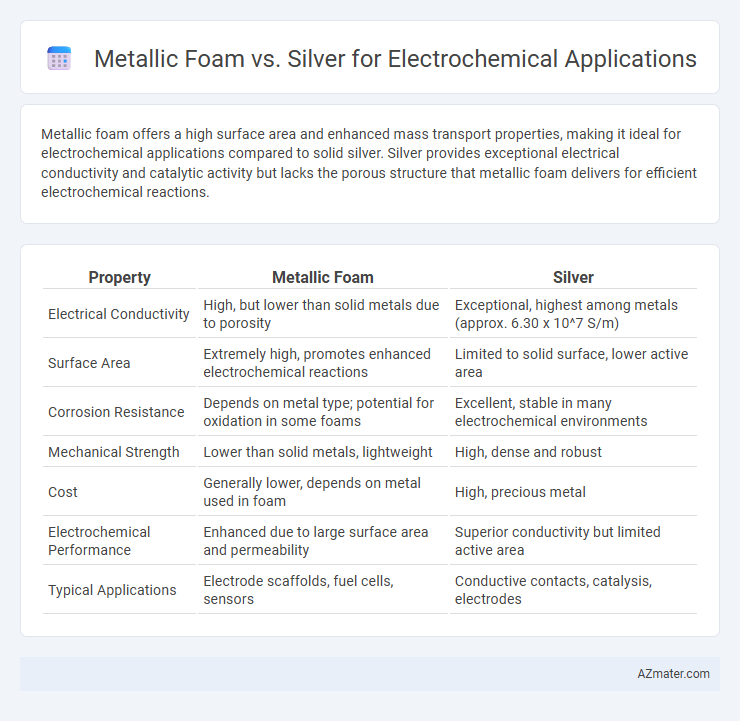Metallic foam offers a high surface area and enhanced mass transport properties, making it ideal for electrochemical applications compared to solid silver. Silver provides exceptional electrical conductivity and catalytic activity but lacks the porous structure that metallic foam delivers for efficient electrochemical reactions.
Table of Comparison
| Property | Metallic Foam | Silver |
|---|---|---|
| Electrical Conductivity | High, but lower than solid metals due to porosity | Exceptional, highest among metals (approx. 6.30 x 10^7 S/m) |
| Surface Area | Extremely high, promotes enhanced electrochemical reactions | Limited to solid surface, lower active area |
| Corrosion Resistance | Depends on metal type; potential for oxidation in some foams | Excellent, stable in many electrochemical environments |
| Mechanical Strength | Lower than solid metals, lightweight | High, dense and robust |
| Cost | Generally lower, depends on metal used in foam | High, precious metal |
| Electrochemical Performance | Enhanced due to large surface area and permeability | Superior conductivity but limited active area |
| Typical Applications | Electrode scaffolds, fuel cells, sensors | Conductive contacts, catalysis, electrodes |
Introduction to Materials in Electrochemical Applications
Metallic foam offers a high surface area and enhanced mass transport, making it ideal for electrochemical applications such as batteries and fuel cells. Silver exhibits excellent electrical conductivity and catalytic properties, particularly beneficial in sensors and electrochemical reduction reactions. Comparing these materials highlights the trade-off between the porous structure of metallic foam and the superior conductivity and catalytic efficiency of silver in electrochemical systems.
Overview of Metallic Foams
Metallic foams offer a unique combination of high surface area, low density, and excellent electrical conductivity, making them ideal for electrochemical applications such as batteries, fuel cells, and supercapacitors. Their porous structure enhances electrolyte accessibility and facilitates ion transport, improving overall device efficiency compared to bulk silver electrodes. While silver provides superior conductivity and corrosion resistance, metallic foams deliver enhanced functional performance due to their three-dimensional interconnected networks and tunable porosity.
Properties and Structure of Silver Electrodes
Silver electrodes exhibit excellent electrical conductivity and chemical stability, making them ideal for electrochemical applications. Their dense, crystalline structure provides superior electron transfer rates and resistance to corrosion compared to porous metallic foam electrodes. Metallic foam offers high surface area but often compromises mechanical strength and long-term stability relative to the intrinsic robustness of silver electrodes.
Electrical Conductivity: Metallic Foam vs Silver
Metallic foam exhibits lower electrical conductivity compared to silver, with typical conductivities ranging from 10^4 to 10^5 S/m due to its porous structure, while silver boasts the highest conductivity among metals at approximately 6.3 x 10^7 S/m. The reduced conductivity of metallic foam results from increased electron scattering at pore surfaces, making it less efficient for high-current electrochemical applications. Silver's superior electrical conductivity ensures minimal energy loss and enhanced performance in electrochemical cells and sensors.
Surface Area and Porosity Comparisons
Metallic foams exhibit significantly higher surface area and porosity compared to bulk silver, enhancing electrochemical reaction sites and mass transport. The porous architecture of metallic foams facilitates better electrolyte penetration and ion diffusion, leading to improved catalytic performance. Silver, while conductive and catalytically active, lacks the extensive porosity and surface area found in metallic foams, limiting its efficiency in high-performance electrochemical applications.
Electrochemical Stability and Durability
Metallic foam demonstrates superior electrochemical stability and durability compared to silver due to its high surface area and porous structure, which enhances ion transport and reduces mechanical stress during cycling. Silver, while highly conductive, often suffers from surface degradation and agglomeration under prolonged electrochemical conditions, limiting its long-term performance. The robust framework of metallic foam materials enables sustained electrochemical reactions and improved lifespan in applications such as batteries and fuel cells.
Catalytic Activity and Performance Metrics
Metallic foam exhibits high surface area and excellent electrical conductivity, enhancing catalytic activity in electrochemical applications by facilitating rapid electron transfer and improved mass transport. Silver, known for its superior catalytic properties and high conductivity, offers outstanding performance metrics such as increased current density and lower overpotential in reactions like oxygen reduction and CO2 reduction. Comparing both, metallic foam provides structural advantages and durability, while silver delivers higher intrinsic catalytic efficiency, making the choice dependent on specific application requirements and cost considerations.
Cost and Scalability Considerations
Metallic foam offers a cost-effective and scalable solution for electrochemical applications due to its lower material costs and ease of mass production compared to silver. Silver, while providing superior conductivity and catalytic properties, incurs higher expenses and limited scalability due to its scarcity and complex manufacturing processes. Industrial adoption favors metallic foam when balancing performance with economical large-scale deployment.
Environmental Impact and Sustainability
Metallic foam offers enhanced surface area and lower material consumption compared to solid silver, reducing resource extraction impacts in electrochemical applications. Silver's environmental footprint is significant due to intensive mining and energy use, whereas metallic foams, often made from abundant metals like aluminum or nickel, present a more sustainable alternative. Recyclability and lower toxicity of metallic foams further contribute to their environmental advantage over silver in sustainable electrochemical system design.
Future Prospects in Electrochemical Technologies
Metallic foam offers superior surface area and enhanced mass transport properties compared to silver, making it a promising material for next-generation electrochemical applications such as energy storage and catalysis. Advances in fabrication techniques and alloy design are expected to improve the durability and conductivity of metallic foams, potentially surpassing silver's performance in fuel cells, batteries, and sensors. Future developments will likely focus on integrating metallic foams with nanostructured catalysts to optimize efficiency and reduce costs in electrochemical technologies.

Infographic: Metallic foam vs Silver for Electrochemical application
 azmater.com
azmater.com